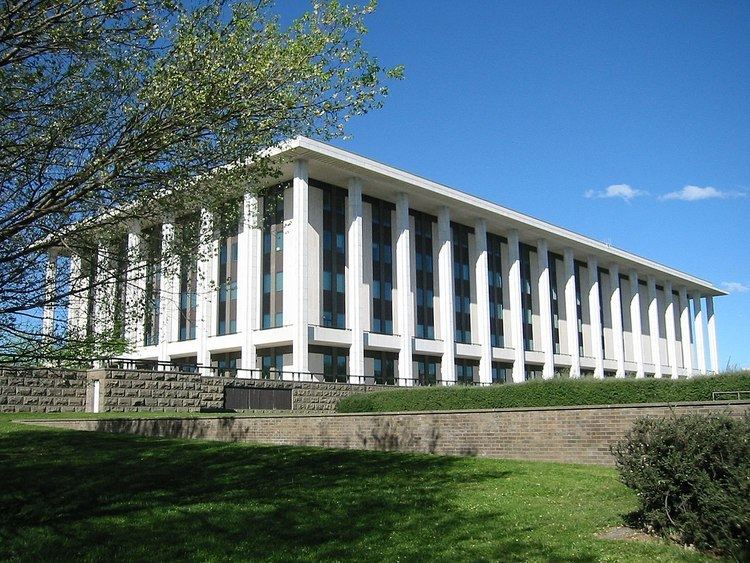Nationality Australian Role Architect | Name Walter Bunning Occupation Architect | |
 | ||
Awards ANZAC House, College Street, Sydney (1957) RIBA Bronze MedalLiner House, Bridge Street, Sydney (1962) Sir John Sulman Medal Practice Carlyle GreenwellStephenson & MeldrumH Ruskin RoweBunning and Madden Buildings Bunning House, Ryrie Street, Mosman (1952)Bruce Hall, Australian National University (1961)International House, University of Sydney (1967)National Library of Australia (1968) Design Homes in the Sun (Published 1945) Died October 13, 1977, Sydney, Australia Books Submission to an Inquiry Conducted by Mr. Walter Bunning Into an Appeal by Mineral Deposits Limited Against the Decision of the State Planning Authority to Refuse Interim Development Permission for Mining the High Dunes East of Myall and Smiths Lakes Structures | ||
Walter Ralston Bunning (19 May 1912 – 13 October 1977) was a prominent Australian architect and urban planner.
Contents
Early life
Bunning was born in Brisbane. During the depression he moved to Sydney to study at East Sydney Technical College graduating in 1936. He then worked in the offices of Carlyle Greenwell and Stephenson & Meldrum while attending Sydney Technical College at night. After his graduation he was awarded a travelling scholarship by the Board of Architects of New South Wales and from 1937–39 he travelled throughout Europe and North America working for prominent architects in London, Dublin and New York. According to Johnson, it was this time overseas that became a crucial time in the evolution of Bunning's design and thought, inspiring modernist design and ideas that could be brought back and applied to Australia.
Working life
In 1938 Bunning returned to Australia and helped to establish the Sydney arm of the Modern Architectural Research Society (MARS) which was modelled on the famous British organisation of the same name. During World War II Bunning's worked for the Australian Government, mainly designing camouflage schemes. However, in 1943 Bunning's was appointed executive officer of the Commonwealth Housing Commission writing much of its influential 1944 report, which according to many scholars became a virtual text book for planners.
Homes in the Sun
Stemming from his work with the Commonwealth Housing Commission in 1945 Bunning published Homes in the Sun. The book advocated better designed homes, communities, towns and regions to suit the Australian environment. This according to Robin Boyd, established Bunning's as 'the best known architectural publicist in the country'. The dream for postwar planning in Australia for which Bunning's highly advocated was displayed clearly throughout the book, with the most prominent example being a proposed attempt to develop Sydney's first satellite town, which according to Freestone was "refined in later writings". Bunning envisaged a town for 10,000 people, which would provide the best of country and city living in one, with the community areas and industrial areas separated to prevent pollution. There would be a clear separation of transport modes and the communities would also be separated, each serviced by their own facilities. With the town defined by a green belt, an area where any further metropolitan sprawl would be contained. This according to Freestone “synthesised the ideas of Ebenezer Howard and Le Corbusier into a normative formula".
The same year Homes in the sun was published Bunning formed his own private architectural firm, joining up with Charles Madden in 1946. The Sydney-based firm over the next 25 years designed many public and private buildings in Sydney and Canberra, including winning the 1949 competition for the design of Anzac House, Sydney. The firm's most famous work however was the National Library in Canberra. The firm had many other successful designs such as International House, University of Sydney (1967), however in 1957 the firm leaned that it had failed in its bid to design the Sydney Opera House.
Career twilight
The late 60s to his death saw the twilight of Bunning's planning career. Bunning became a highly sought after planning figure as both state governments and private developers became resolved for Bunning to act as an independent adviser on major planning issues. This according to Freestone led to the phrase "Send for Bunning'…. as he became a kind of 'ombudsman extraordinary' helping the government 'out of tight spots".
In 1970 Bunning was appointed to the Sydney Cove Redevelopment Authority (SCRA), this proved to be a controversial project with Bunning's forced to bear some responsibility for plans to build high-rise hotels and office blocks in The Rocks, Sydney.
Although Bunning chaired many architectural and planning bodies, he did find time to support other interests, becoming a trustee of the Art Gallery of New South Wales in 1958 and taking over as president from 1974 until his death of a cerebral tumour in 1977.
